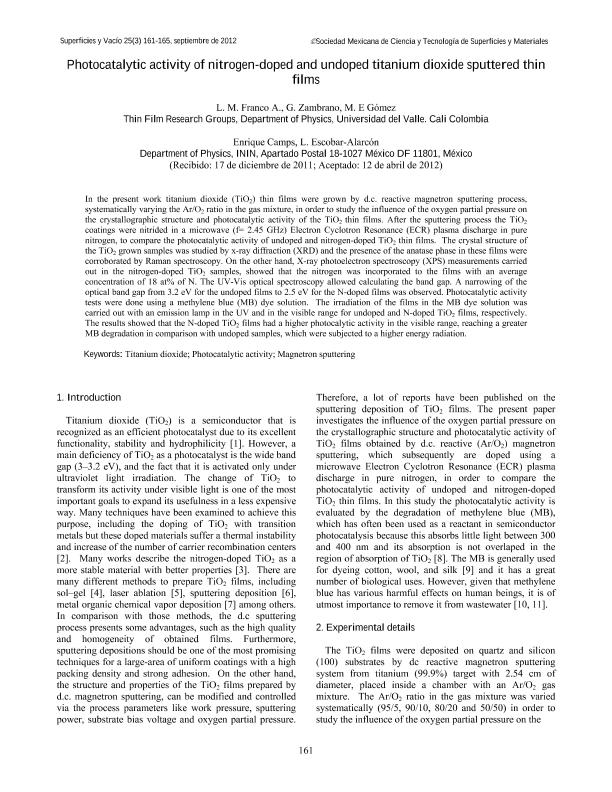Mostrar el registro sencillo del ítem
dc.contributor.author
Franco Arias, Lina Maria

dc.contributor.author
Zambrano, G.
dc.contributor.author
Gómez, M. E.
dc.contributor.author
Camps, E.
dc.contributor.author
Escobar Alarcón, L.
dc.date.available
2017-07-20T20:26:44Z
dc.date.issued
2012
dc.identifier.citation
Franco Arias, Lina Maria; Zambrano, G.; Gómez, M. E.; Camps, E.; Escobar Alarcón, L.; Photocatalytic activity of nitrogen-doped and undoped titanium dioxide sputtered thin films; Sociedad Mexicana de Ciencia y Tecnología de Superficies y Materiales; Revista Superficies y Vacio; 25; 3; 2012; 161-165
dc.identifier.issn
1665-3521
dc.identifier.uri
http://hdl.handle.net/11336/21043
dc.description.abstract
In the present work titanium dioxide (TiO2) thin films were grown by d.c. reactive magnetron sputtering process, systematically varying the Ar/O2 ratio in the gas mixture, in order to study the influence of the oxygen partial pressure on the crystallographic structure and photocatalytic activity of the TiO2 thin films. After the sputtering process the TiO2 coatings were nitrided in a microwave (f= 2.45 GHz) Electron Cyclotron Resonance (ECR) plasma discharge in pure nitrogen, to compare the photocatalytic activity of undoped and nitrogen-doped TiO2 thin films. The crystal structure of the TiO2 grown samples was studied by x-ray diffraction (XRD) and the presence of the anatase phase in these films were corroborated by Raman spectroscopy. On the other hand, X-ray photoelectron spectroscopy (XPS) measurements carried out in the nitrogen-doped TiO2 samples, showed that the nitrogen was incorporated to the films with an average concentration of 18 at% of N. The UV-Vis optical spectroscopy allowed calculating the band gap. A narrowing of the optical band gap from 3.2 eV for the undoped films to 2.5 eV for the N-doped films was observed. Photocatalytic activity tests were done using a methylene blue (MB) dye solution. The irradiation of the films in the MB dye solution was carried out with an emission lamp in the UV and in the visible range for undoped and N-doped TiO2 films, respectively. The results showed that the N-doped TiO2 films had a higher photocalytic activity in the visible range, reaching a greater MB degradation in comparison with undoped samples, which were subjected to a higher energy radiation.
dc.format
application/pdf
dc.language.iso
eng
dc.publisher
Sociedad Mexicana de Ciencia y Tecnología de Superficies y Materiales
dc.rights
info:eu-repo/semantics/openAccess
dc.rights.uri
https://creativecommons.org/licenses/by-nc-sa/2.5/ar/
dc.subject
Titanium Dioxide
dc.subject
Magnetron Sputtering
dc.subject
Photocatalytic Activity
dc.subject.classification
Física de los Materiales Condensados

dc.subject.classification
Ciencias Físicas

dc.subject.classification
CIENCIAS NATURALES Y EXACTAS

dc.title
Photocatalytic activity of nitrogen-doped and undoped titanium dioxide sputtered thin films
dc.type
info:eu-repo/semantics/article
dc.type
info:ar-repo/semantics/artículo
dc.type
info:eu-repo/semantics/publishedVersion
dc.date.updated
2017-06-30T14:37:09Z
dc.journal.volume
25
dc.journal.number
3
dc.journal.pagination
161-165
dc.journal.pais
México

dc.description.fil
Fil: Franco Arias, Lina Maria. Consejo Nacional de Investigaciones Científicas y Técnicas; Argentina. Universidad del Valle; Colombia
dc.description.fil
Fil: Zambrano, G.. Universidad del Valle; Colombia
dc.description.fil
Fil: Gómez, M. E.. Universidad del Valle; Colombia
dc.description.fil
Fil: Camps, E.. Instituto Nacional de Investigaciones Nucleares; México
dc.description.fil
Fil: Escobar Alarcón, L.. Instituto Nacional de Investigaciones Nucleares; México
dc.journal.title
Revista Superficies y Vacio
dc.relation.alternativeid
info:eu-repo/semantics/altIdentifier/url/http://smctsm.org.mx/ojs/index.php/SyV/article/view/198
dc.relation.alternativeid
info:eu-repo/semantics/altIdentifier/url/http://www.redalyc.org/articulo.oa?id=94224555003
Archivos asociados
